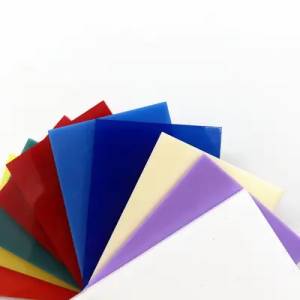Description
Acrylic: Versatility and Elegance in One
Acrylic, also known as polymethyl methacrylate (PMMA) or plexiglass, is a remarkably versatile synthetic polymer with a wide range of applications. Its clear transparency rivals that of glass, but with significant advantages in terms of weight, durability, and workability. This detailed description explores the key features and benefits of acrylic, highlighting its suitability for diverse projects.
Key Features:
- Exceptional Clarity and Transparency: Acrylic boasts a light transmission rate comparable to, and often exceeding, that of glass. This makes it ideal for applications where maximum light transmission is crucial, such as display cases, windows, and lighting fixtures.
- Lightweight and Durable: Significantly lighter than glass, acrylic is also more resistant to breakage and shattering under impact. This makes it a safer and more practical alternative in many situations. Its resistance to weathering and UV degradation ensures long-lasting performance, even outdoors.
- Easy to Fabricate: Acrylic can be easily cut, shaped, drilled, and polished using standard tools. This ease of fabrication contributes to its popularity in both professional and DIY applications. It can be thermoformed into complex shapes, opening up possibilities for creative design.
- Variety of Colors and Finishes: While transparent acrylic is the most common, it's also available in a wide spectrum of colors and finishes, including frosted, mirrored, and patterned options. This allows for a high degree of customization and design flexibility.
- Chemical Resistance: Acrylic exhibits good resistance to many chemicals, making it suitable for use in environments where exposure to certain substances is expected. However, it's crucial to consult material compatibility charts for specific chemicals.
- Weather Resistance: Specifically formulated outdoor acrylic sheets are resistant to UV degradation and weathering, making them suitable for outdoor signage, architectural features, and other exterior applications.
Applications:
Acrylic's versatility makes it suitable for countless applications, including:
- Displays and Signage: Showcase products, artwork, or information with crystal-clear acrylic displays and signs.
- Architectural Features: Incorporate acrylic into building designs for windows, partitions, skylights, and decorative elements.
- Lighting Fixtures: Create stunning lighting effects with acrylic's light-transmitting properties.
- DIY Projects: From crafting custom furniture to making protective covers, acrylic offers endless DIY possibilities.
- Protective Barriers: Its impact resistance makes it suitable for protective shields and barriers in various settings.
- Medical Devices: Its clarity and biocompatibility properties make it suitable for certain medical applications.
Choosing the Right Acrylic:
When selecting acrylic, consider the following factors:
- Thickness: Choose a thickness appropriate for the intended application and expected stresses.
- Color and Finish: Select the color and finish that best suits the aesthetic requirements of your project.
- UV Resistance: For outdoor applications, ensure the acrylic is specifically formulated for UV resistance.
Conclusion:
Acrylic is a superior material offering a balance of clarity, durability, and ease of fabrication. Its versatility and aesthetic appeal make it a popular choice for a wide range of applications, from professional projects to individual creative endeavors. With careful consideration of the specific needs of your project, acrylic can provide a long-lasting and visually stunning solution.
